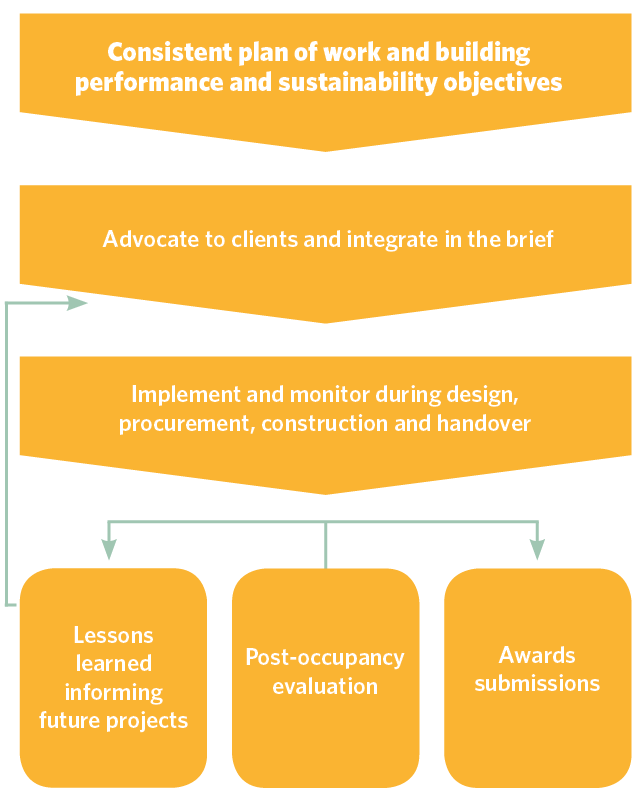The need for collaboration was highlighted in Paul Morrell’s 2015 report for the Edge, Collaboration for Change, in this year’s post-Grenfell review by Dame Judith Hackitt, Building a Safer Future, and – most recently – in a new book Professionalism for the Built Environment, by Simon Foxell, architect and member of the Edge. Recent initiatives involving the RIBA Sustainable Futures Group and CIBSE are positive examples of how professionals from different institutions can work together to try to align their objectives on building performance and wider sustainability.
RIBA Plan of Work and sustainability overlay
RIBA is reviewing the sustainability guidance given to support its Plan of Work. CIBSE has been invited to inform the revisions, along with clients, contractors and other design professions. The changes will:
- Make it clear that sustainability should be considered and integrated in every project – currently some aspects of the Plan of Work can make it look optional
- Simplify the structure of the guidance, with clearer links between the sustainability objectives in the Plan of Work and the more detailed guidance. This should give sustainability objectives more prominence – see Figure 1
- Update the guidance to reflect changes to sustainable building practice since the publication of the Green Overlay (2011 and revised 2013), although much of the original guidance produced by Bill Gething is still relevant and is expected to be retained
- Help architects and building services engineers work to the same level of detail simultaneously, with more clearly defined design-stage boundaries and detailed guidance on what is ‘coordinated design’.
These changes should help project teams better advise clients on how to embed building performance and sustainability in the brief and then follow them through the design, procurement, construction and handover stages. Post-occupancy evaluation (POE) is prominent in the proposed revisions, to encourage POE on completed buildings and to incorporate lessons from previous projects into the brief and design proposals.

Figure 1: Collaboration on building performance and sustainability objectives: the end game?
CIBSE and the RIBA Sustainable Futures Group are planning to work together to produce advice on what constitutes building performance and sustainability, with objectives clearly referenced in the Plan of Work to inform project briefs and POE. While energy and/or carbon targets are relatively widely used, there is a high level of discrepancy in how other aspects of building performance are considered. Greater consistency would be useful to make a case to clients and is essential across disciplines, as most aspects of building performance cannot be delivered by a single discipline.
For example, indoor air quality needs attention from the architect for the building layout, façade and specification of materials; from the engineer for the ventilation strategy; and from the contractor for construction procedures. All disciplines need to work from a common understanding of what constitutes good indoor air quality before they can put forward objectives and develop design proposals.
The RIBA Sustainable Futures Group and CIBSE are also planning to review how the sustainability criteria for their awards can be more closely aligned, to encourage a greater focus on building performance. This would send a strong message to clients and project teams on what to target and report on. It would also start breaking down the distinction between engineering and architectural awards, with the latter often seen to be given to buildings that do not emphasise how they actually perform.
There is still much to be done, but these strands of work are all leading to stronger and more consistent messages, to help teams throughout the project cycle.

